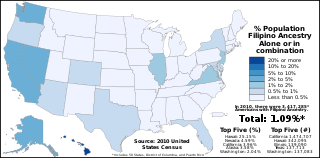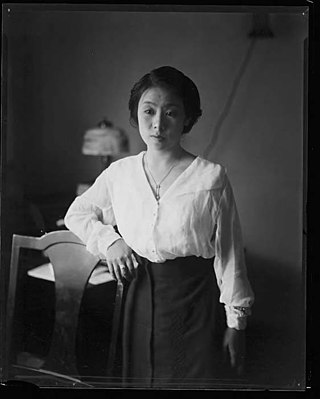
Stockton is a city in and the county seat of San Joaquin County in the Central Valley of the U.S. state of California. Stockton is the largest city in the county, the 11th largest city in California and the 58th largest city in the United States. Stockton's population in 2020 was 320,804. It was named an All-America City in 1999, 2004, 2015, and again in 2017. The city is located on the San Joaquin River in the northern San Joaquin Valley.

Filipino Americans are Americans of Filipino ancestry. Filipinos and other Asian ethnicities in North America were first documented in the 16th century as slaves and prisoners on ships sailing to and from New Spain (Mexico) and a handful of inhabitants in other minute settlements during the time Louisiana was an administrative district of the Viceroyalty of New Spain (Mexico). Mass migration did not begin until the 20th century, when the Philippines was a U.S. territory.

A Little Manila, also known as a Manilatown or Filipinotown, is a community with a large Filipino immigrant and descendant population. Little Manilas are enclaves of Overseas Filipinos consisting of people of Filipino origin living outside of the Philippines.

Eduardo Villanueva Manalo also known as Ka Eduardo is the current Executive Minister of the Iglesia ni Cristo (INC). He is the third generation of the Manalo family to lead the church following his father, the late Eraño G. Manalo, and his grandfather, Felix Y. Manalo.

Victoria Manalo Draves was a Filipino American competitive diver who won gold medals in both platform and springboard diving at the 1948 Summer Olympics in London. Draves became the first woman to be awarded gold medals for both the ten-meter platform and the three-meter springboard. Additionally, Draves became the first American woman to win two gold medals in diving, and the first Asian American to win Olympic gold medals. She was born in San Francisco.
Filipino American History Month (FAHM) is celebrated in the United States during the month of October. In 1991, Filipino American National Historical Society (FANHS) board of trustees proposed the first annual Filipino American History Month to commence in October 1992.
This is an alphabetical index of topics related to Asian Americans.

Asian American history is the history of ethnic and racial groups in the United States who are of Asian descent. The term "Asian American" was an idea invented in the 1960s to bring together Chinese, Japanese, and Filipino Americans for strategic political purposes. Soon other groups of Asian origin, such as Korean, Vietnamese, Iu Mien, Hmong, and South Asian Americans were added. For example, while many Chinese, Japanese, and Filipino immigrants arrived as unskilled workers in significant numbers from 1850 to 1905 and largely settled in Hawaii and California, many Vietnamese, Cambodian, and Hmong Americans arrived in the United States as refugees following the Vietnam War. These separate histories have often been overlooked in conventional frameworks of Asian American history.
Little Manila is an area in Stockton, California that was inhabited by predominantly Filipino American agricultural workers from the 1930s on.

Thelma Garcia Buchholdt was a Filipino American community activist, politician, historian, public speaker, cultural worker, and author. She was elected to the Alaska House of Representatives for four consecutive terms, from 1974 through 1982. She was the author of the book Filipinos in Alaska: 1788-1958, which is now in its third printing and is available through the Anchorage Museum at Rasmuson Center.

Kevin Nadal is an author, activist, comedian, and Distinguished Professor of Psychology at John Jay College of Criminal Justice and The Graduate Center of the City University of New York. He is a researcher and expert on the effects of microaggressions on racial/ethnic minorities and LGBTQ people.

The history of Filipino Americans begins indirectly, when Filipino slaves and indentured servants first visited what is now the United States aboard Novohispanic ships sailing to and from modern Mexico and Asia, loaded with cargo and prisoners. The first ship carrying these slaves docked around Morro Bay in Alta California territory under the control of Mexico City in the Viceroyalty of New Spain and then Madrid. Until the 19th century the Philippines continued to be geographically isolated but maintained regular communication across the Pacific Ocean via the Manila galleon. A few Filipino seamen and indentured servants managed to escape the Spanish Galleons in the 1700s and settled on the coast or in Louisiana, another territory. One single Filipino living in the United States fought in the Battle of New Orleans. In the final years of the 19th century, the United States went to war with Spain, ultimately annexing the Philippine Islands from Spain. Due to this, the History of the Philippines now includes domination from the United States, beginning with the three-year-long Philippine–American War (1899-1902), which resulted in the defeat of the First Philippine Republic, and the attempted Americanization of the Philippines.

The demographics of Filipino Americans describe a heterogeneous group of people in the United States who trace their ancestry to the Philippines. As of the 2010 Census, there were 3.4 million Filipino Americans, including Multiracial Americans who were part Filipino living in the US; in 2011 the United States Department of State estimated the population at four million. Filipino Americans constitute the second-largest population of Asian Americans, and the largest population of Overseas Filipinos.

Modesto "Larry" Dulay Itliong, also known as "Seven Fingers", was a Filipino American labor organizer. He organized West Coast agricultural workers starting in the 1930s, and rose to national prominence in 1965, when he, Philip Vera Cruz, Benjamin Gines and Pete Velasco, walked off the farms of area table-grape growers, demanding wages equal to the federal minimum wage, that became known as the Delano grape strike. He has been described as "one of the fathers of the West Coast labor movement." He is regarded as a key figure of the Asian American movement.
Pinoy Capital: The Filipino Nation in Daly City is a 2009 non-fiction book by Benito Manalo Vergara and published by Temple University Press. The book received favorable reviews from critics.

Little Manila Is in the Heart: The Making of the Filipina/o American Community in Stockton, California by Dawn Bohulano Mabalon is a book with three parts that depict the formation of Filipina/o American identities and community in the Little Manila in Stockton, California during the twentieth century. The book touches on issues including immigration, colonialism, race, gender, labor, and activism. Bohulano Mabalon draws on rich oral histories as well as historical archives such as the National Pinoy Archives and Filipino American National Historical Society to provide an analysis on Filipina/o experience. The book won the honorable mention for the Frederick Jackson Turner Award by the Organization of American Historians in 2014.

On October 18, 1587, the first Filipinos landed in what is now the Continental United States at Morro Bay. They arrived as slaves, prisoners and crew aboard the Nuestra Señora de Buena Esperanza, which had sailed from Portuguese Macau, as part of the Manila galleon trade between the Viceroyalty of New Spain (Mexico) and its subordinate territories in the East Indies. During about three days of travels ashore around Morro Bay, the crew of the Nuestra Señora de Buena Esperanza came in contact with the Chumash people, ultimately resulting in the death of a Filipino crew member.

Dawn Bohulano Mabalon was an American academic who worked on documenting the history of Filipino Americans. Mabalon was born in Stockton, and earned her doctoral degree from Stanford University; she later taught at San Francisco State University. Mabalon was the co-founder of The Little Manila Foundation, which worked to preserve Little Manila in Stockton, California. During her life, her work elevated the topic of the history of Filipino Americans, in Central California in particular.
















